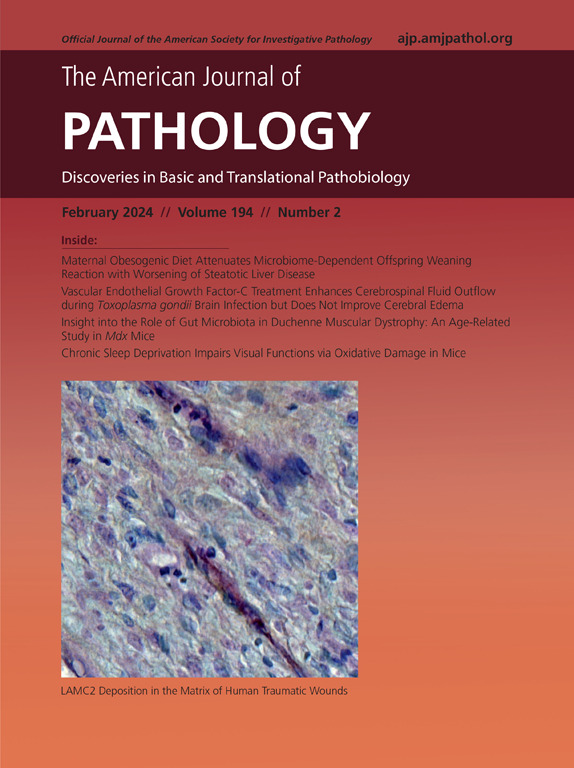Insulin-Like Growth Factor 2 mRNA-Binding Protein 2 Drives Subchondral Bone Damage in Temporomandibular Joint Osteoarthritis through Peroxisome Proliferator-Activated Receptor γ/Cellular FOS Proto-oncogene–Regulated Dual Pathways
IF 3.6
2区 医学
Q1 PATHOLOGY
引用次数: 0
Abstract
Overactivated osteoclastogenesis leading to abnormal subchondral bone loss is the main feature of temporomandibular joint osteoarthritis (TMJOA) deterioration. The role of N6-methyladenosine in osteoclast-mediated subchondral bone loss in TMJOA remains unknown. Here, it was found that an N6-methyladenosine reader insulin-like growth factor 2 mRNA-binding protein 2 (IGF2BP2) was essential for mature osteoclast induction. In TMJ tissues of patients with TMJOA, the expression of IGF2BP2 was increased. Moreover, IGF2BP2 was augmented in subchondral bone of monosodium iodoacetate (MIA)–induced TMJOA mice. Igf2bp2 deficiency attenuated MIA-induced subchondral bone loss and suppressed osteoclast function. Mechanistically, IGF2BP2 directly stabilized Pparg and Fos mRNA to enhance the nuclear factor of activated T cells 1 (NFATC1) signaling, thereby inducing osteoclast maturation. Furthermore, the stabilized peroxisome proliferator-activated receptor γ (PPARγ) promoted the transcription of Fos, resulting in a further amplified signaling of NFATC1. In Igf2bp2-deficient cells, overexpression of PPARγ and cellular FOS proto-oncogene (C-FOS) rescued the function of osteoclasts through restoring reduced levels of NFATC1. On the other hand, the IGF2BP2/PPARγ/C-FOS axis facilitated the formation of osteoclasts by restoring the inhibited autophagy levels through the down-regulation of autophagy-related 16-like 2. IGF2BP2 inhibitor, CWI1-2, hindered osteoclast formation and mitigated synovial inflammation, cartilage degeneration, and bone destruction in MIA-induced TMJOA mice. In summary, IGF2BP2 may be a novel regulator of osteoclastogenesis of TMJOA pathogenesis, which aggravates TMJOA pathology via stabilizing Pparg and Fos mRNA, thereby promoting NFATC1-mediated osteoclast signaling and autophagy-related 16-like 2–mediated autophagy.
IGF2BP2通过PPARγ/ c - fos调控的双途径驱动颞下颌关节骨性关节炎软骨下骨损伤:NFATC1信号和atg16l2介导的自噬。
破骨细胞生成过度激活导致软骨下骨异常丢失是颞下颌关节骨性关节炎(TMJOA)恶化的主要特征。n6 -甲基腺苷(m6A)在破骨细胞介导的TMJOA软骨下骨丢失中的作用尚不清楚。在这里,我们发现m6A读取器IGF2BP2对于诱导成熟破骨细胞至关重要。在TMJOA患者的TMJ组织中,IGF2BP2表达升高。此外,IGF2BP2在碘乙酸钠(MIA)诱导的TMJOA小鼠软骨下骨中表达增强。Igf2bp2缺乏可减轻mia诱导的软骨下骨丢失和抑制破骨细胞功能。机制上,IGF2BP2直接稳定Pparg和Fos mRNA,增强NFATC1信号,从而诱导破骨细胞成熟。此外,稳定的PPARγ促进了Fos的转录,导致NFATC1信号进一步扩增。在igf2bp2缺陷细胞中,过表达PPARγ和C-FOS通过恢复降低的NFATC1水平来挽救破骨细胞的功能。另一方面,IGF2BP2/PPARγ/C-FOS轴通过下调ATG16L2,恢复被抑制的自噬水平,促进破骨细胞的形成。在mia诱导的TMJOA小鼠中,使用IGF2BP2抑制剂CWI1-2可以抑制破骨细胞的形成,减轻滑膜炎症、软骨变性和骨破坏。综上所述,IGF2BP2可能作为TMJOA发病机制中破骨细胞发生的新调控因子,通过稳定Pparg和Fos mRNA,促进nfatc1介导的破骨细胞信号传导和atg16l2介导的自噬,从而加重TMJOA的病理。
本文章由计算机程序翻译,如有差异,请以英文原文为准。
求助全文
约1分钟内获得全文
求助全文
来源期刊
CiteScore
11.40
自引率
0.00%
发文量
178
审稿时长
30 days
期刊介绍:
The American Journal of Pathology, official journal of the American Society for Investigative Pathology, published by Elsevier, Inc., seeks high-quality original research reports, reviews, and commentaries related to the molecular and cellular basis of disease. The editors will consider basic, translational, and clinical investigations that directly address mechanisms of pathogenesis or provide a foundation for future mechanistic inquiries. Examples of such foundational investigations include data mining, identification of biomarkers, molecular pathology, and discovery research. Foundational studies that incorporate deep learning and artificial intelligence are also welcome. High priority is given to studies of human disease and relevant experimental models using molecular, cellular, and organismal approaches.

 求助内容:
求助内容: 应助结果提醒方式:
应助结果提醒方式:


